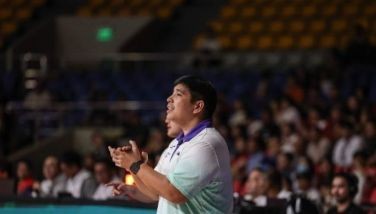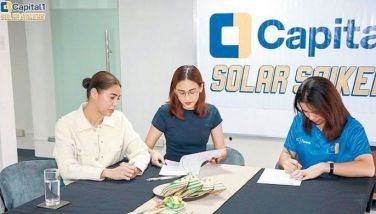Are foreign student-athletes bad for Philippine sports?

MANILA, Philippines – Rep. Mikee Romero (1-Pacman party-list) recently filed a resolution for the banning of foreign players in school programs. Romero cited the following for his reasons:
- Foreign players stymie the growth and shortchange the development of various sports programs in the Philippines.
- They take away playing time from Filipino players.
- Acquiring foreigners is not only counter-productive but is also expensive.
Is that the case?
If you look at this Season 82 of the UAAP, yes, foreign student-athletes are dominating.
Angelo Kouame leads Ateneo in playing time with 25 minutes per game. Four Blue Eagles average 20-plus minutes a game. Five others average over 10 minutes per game. Kouame is also their leading scorer, rebounder and shot blocker. Thirdy Ravena is the only other player in double digits.
In Season 81, Kouame was second in minutes played and points on the team.
Adamson University’s Lenda Douanga averages 33 minutes per game. Jerrick Ahanmisi averages 32. Three others average over 20 minutes per game. Two others average over 10 minutes of playing time. Douanga is third in team scoring.
Far Eastern University’s Patrick Tchuente is second to Wendell Comboy with 25 minutes per game. Three others hit 20-plus minutes. Four others average over 10 minutes a game. Tchuente is fourth in the team in scoring.
Issa Gaye is second in National University in minutes played (Dave Ildefonso is tops). Two others average over 20 minutes while five others play more than 10 minutes per game. Gaye is third in scoring for the Bulldogs. In Season 81, he was fifth in minutes played and scoring.
Alex Diakhite is second in minutes to Rey Suerte for UE in minutes played. Nine others average double digits in minutes played. Diakhite is also second to Suerte in scoring.
Bright Akhuetie is second in minutes played for UP behind Kobe Paras. Seven others average over 10 minutes per game. He is likewise second to Paras in scoring. In Season 81, Akhuetie was third in minutes played and second in scoring.
For UST, Soulemane Chabi Yo leads the Growling Tigers in minutes played. Eight others play more than 10 minutes per game. Chabi Yo has 98 attempts from the field – 20 more than Rhenz Abandom and 18 more than Mark Nonoy. Like Kouame, Chabi Yo leads UST in scoring and rebounding. He is second to Abando in blocked shots.
While they are dominant as of now, it is hard to say that it is the trend. Before we explain, let’s backtrack.
In this modern era, it wasn’t even Africans who started out in the UAAP (the NCAA though is different). La Salle paraded Serbian Marko Batricevic in 2007 alongside Indonesian forward-center Ferdinand. Ateneo featured American Kirk Long also that year, although he did go to school in the Philippines at Faith Academy.
It was in 2009 when Pipo Noundou suited up for FEU, making him the first African in the modern era to play in the UAAP (San Beda opened the doors for this in 2006 over at the NCAA). UE had one years earlier, but he didn’t really fly. In 2010, NU’s Emmanuel Mbe made his debut and was named to the Mythical Five.
In the 10 years that there were Africans plying their trade in the UAAP, only three were named the league’s Most Valuable Player – Ben Mbala (2016-17) and Bright Akhuetie (2018). The first seven years saw studs like UST’s Karim Abdul, NU’s Mbe and Aroga, and UE’s Charles Mammie and Moustapha Arafat suit up. Adamson had Austin Manyara and then Ingrid Sewa. But who were the league MVPs? RR Garcia, Ray Parks (twice), Terrence Romeo and Kiefer Ravena (twice as well). Granted the last three MVPs are Africans and it looks like UST’s Soulemane Chabi Yo is on track for a fourth. Maybe it is a trend.
On the other hand, of the last 10 Finals MVPs, only one African has won it – Aroga in 2015.
Let’s backtrack further.
In Season 77 when National University won the UAAP crown, Aroga was in his first year. The Cameroonian averaged 10.4 points on 50% field goal shooting, 9.1 rebounds per game, and 2.2 blocks. But the main weapons were Troy Rosario, Glenn Khobuntin, Gelo Alolino, and Henri Betayene.
NU did not win in the next two years and here are his stats:
Season 78: 13.2 PPG 44% FG 12.9 RPG 1.7 BPG
Season 79: 10.3 PPG 42% FG 10.1 RPG 1.6 BPG
Far Eastern University captured the Season 78 crown when Prince Orizu was a rookie.
This was his average for the year – 4.1 points on 67% shooting, 6.1 rebounds, and 0.8 blocks. He wasn’t that huge as that team had Mac Belo, Richard Escoto, Mike Tolomia, Raymar Jose, and Roger Pogoy.
Here are Orizu’s stats in the next few years:
Season 79: 6.4 PPG 41% FG 9.8 RPG 1.7 BPG
Season 80: 7.7 PPG 63% FG 8.6 RPG 1.3 BPG
Season 81 7.8 PPG 71% FG 9.0 RPG 1.4 BPG
In Season 79, Ben Mbala wreaked havoc on the UAAP with his averages of 20.6 points on 55% shooting to go with 16.0 rebounds, and 2.4 blocks. He also had Jeron Teng, Thomas Torres, Aljun Melecio, Andrei Caracut and Kib Montalbo.
The next year, Season 80, Mbala hiked his scoring to 26.0 points although his field goal accuracy dipped a bit to 52% He also normed 13.1 boards to go with 2.5 blocks. In spite of his dominance, DLSU fell to Ateneo, which wasn’t carried by their foreign player in Chib Ikeh but Matt Nieto, Thirdy Ravena, Isaac Go and Anton Asistio.
Save for Mbala who was a force of nature, Alfred Aroga and Orizu were just one of the players.
Oh, in the NCAA… the San Beda Red Lions proved a massive point when they bagged the 2011 without any foreign player. And they beat a San Sebastian team featuring Calvin Abueva and company.
Two local Ateneo teams defeated FEU and UST teams that featured foreign players in the Finals. La Salle also won one without a foreign player against a Karim Abdul-powered UST. Ateneo won with a role player in Chibueze Ikeh to take down a Ben Mbala-powered La Salle team.
Let us take a look at the PBA Draft from 2015 onwards. The Fil-foreigners are italicized.
2015 PBA Draft
Moala Tautua first overall
Norbert Torres eighth overall (Norbert isn’t even a true center. He used to play the three in Canada but was forced to move up because of his height).
Bradwyn Guinto second pick second round
Marion Magat sixth second round
Michael Miranda ninth second round
Alfred Batino fifth in the fifth round
2016 PBA Draft
Jericho de Guzman College of St Benilde ninth
Tristan Perez National University 11th
Spencer Eman 20th
None of these guys were even stars on their college teams.
2017 PBA Draft
Christian Standhardinger first overall pick. He can play the four or five but his more natural position is the four.
Lervin Flores ninth overall pick started for Arellano University
Jonjon Gabriel 11th
Joseph Gabayni 14th
Only Flores was a big name coming out of college.
2018 PBA Draft
Abu Tratter seventh overall but isn’t technically a center. He played alongside Arnold Van Opstal and later Ben Mbala. In fact, he was more effective playing alongside Mbala.
Jeepy Faundo 15th, played alongside Karim Abdul and Steve Akomo
GBoy Babilonia 17th, started if not played alongside Chibueze Ikeh
Chris dela Peña 40th
As you can see, there aren’t much.
Let’s take a look at the current PBA teams and who play the center slot. Once more, the names of Fil-foreigners are italicized.
San Miguel Beermen
Billy Mamaril 6’6” and a 16-year veteran
June Mar Fajardo 6’11” seven-year veteran
Yancy de Ocampo 6’9” 17-year veteran
Kelly Nabong 6’6” seven-year veteran
Christian Standhardinger 6’8” two-year veteran
Barangay Ginebra
Prince Caperal 6’7” five-year veteran
Greg Slaughter 7’0” six-year veteran
Japeth Aguilar 6’9” 10-year veteran
Magnolia Hotshots
Ian Sangalang 6’7” six-year veteran
Kyle Pascual 6’6” five-year veteran
Rodney Brondial 6’5” five-year veteran
Rain or Shine Elasto Painters
Jewel Ponferada 6’5” seven-year veteran
Norbert Torres 6’6” four-year veteran
Alaska Aces
GBoy Babilonia 6’6” first year
Sonny Thoss 6’7” 15-year veteran
Phoenix Fuel Masters
Justin Chua 6’6” six-year veteran
Dave Marcelo 6’5” seven-year veteran
BlackWater Elite
James Sena 6’5” eight-year veteran
Rabeh Al-Hussaini 6’7” eight-year veteran
Chris Javier 6’4 three-year veteran
TNT Ka Tropa
Frank Golla 6’5” five-year veteran
Marion Magat 6’7 five-year veteran
Ken Bono 6’5” 12-year veteran
Troy Rosario 6’7 4-year veteran
Yousef Taha 6’7 seven-year veteran
NLEX Road Warriors
Michael Miranda 6’6 four-year veteran
JP Erram 6’8 five-year veteran
Raul Soyud 6’5” three-year veteran
Philip Paredes 6’5
Meralco Bolts
Bryan Faundo 6’6” 10-year veteran
Raymond Almazan 6’8” six-year veteran
Columbian Dyip
Jonjon Gabriel 6’6” two-year veteran
Jeepy Faundo 6’6” first year
Lervin Flores 6’5” two-year veteran
Joseph Gabayni 6’5” two-year veteran
NorthPort Batang Pier
Moala Tautuaa 6’8” four-year veteran
Bradwyn Guinto 6’6” four-year veteran
Russel Escoto 6’6” three-year veteran
The average height of the PBA center is 6’6”. Many of these players are actually stretch players. There are few who are the traditional five-spot players.
The position of center is a premium one. There aren’t many as evidenced via the PBA Draft. They are so few and far in between. The PBA players we listed are long standing veterans. Ten of them are Fil-foreigners or who grew up overseas. Meaning, they aren’t easily replaced because there are so few. If there are few, so how is it that position is in danger? How is that that local homegrown centers are displaced?
How many foreign players are in the basketball leagues of the UAAP, NCAA, and CESAFI?
UAAP – 7
NCAA – 5
CESAFI –6
There are a few others in other sports, but not much.
According to the US NCAA, as of today, there are 20,000 foreign student-athletes among the 490,000 playing in Divisions I, II and III. And that is the US.That is 4.08% of all student-athletes.
What makes it amazing is that they are more open minded to things lack that. In the Philippines, there are less than a hundred.
The funny thing is Rep. Romero calls for a ban on foreign student athletes but he also says we need to naturalize more players. Does that even make sense?
Foreign student-athletes have been playing as far back as when the NCAA or even the UAAP was formed. UST had African and even European athletes on their football teams. UP featured Ghanaian Ayi Aryee while FEU had a Korean youngster in their college team.
I think what galls some quarters today is how it has been abused. Back in the late 1990s and early years of the new millennium, Fil-foreigners proliferated in college ball and pro ball. Leagues, even the pro loop, put in some restrictions. Crazy isn’t it?
Expensive? Why he is he talking about expenses when it isn’t the school paying for it but team patrons?
If you look at the formation of the national teams, see how the number of Fil-foreigners declined over the years.
|
Tournament |
Number of Fil-foreigners |
Finish |
|
2007 Fiba Asia |
9 |
9th |
|
2011 Fiba Asia |
3 |
4th |
|
2013 Fiba Asia |
2 |
2nd; silver medal |
|
2014 Fiba World Cup |
2 |
21st |
|
2015 Fiba Asia |
4 |
2nd, silver medal |
|
2017 Fiba Asia |
3 |
3rd |
|
2019 Fiba World Cup |
1 |
32nd |
How is there are correlation in the poor finish of the 2019 FIBA World Cup with foreigners playing college leagues?
You have to wonder about these calls for “Philippines this, Philippines that.” It is false pride. It is rather insular in thinking.
- Latest
- Trending



























